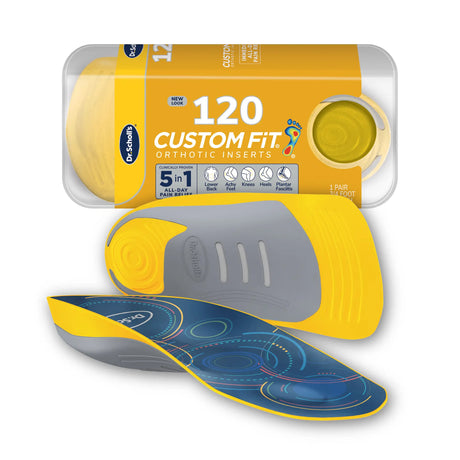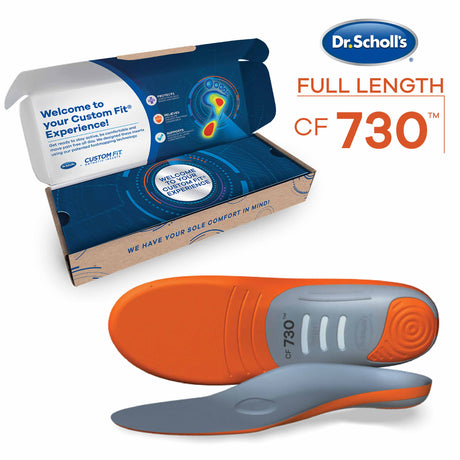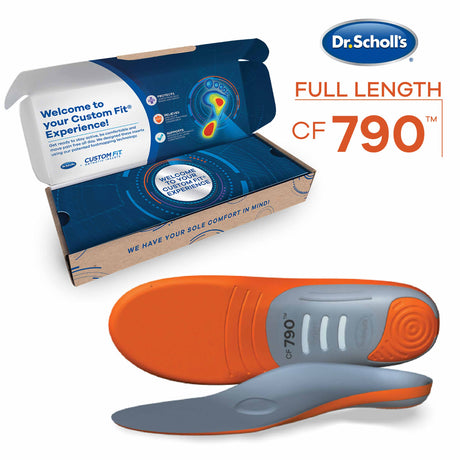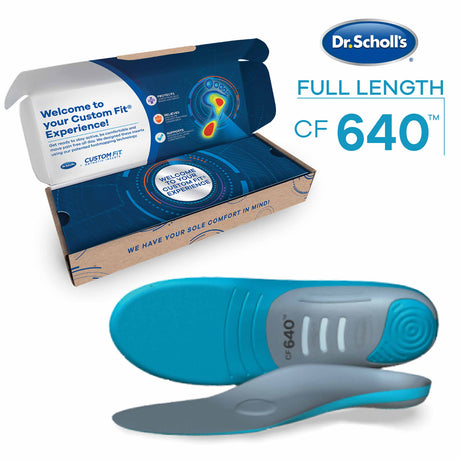Sore Foot Pain FAQs
Economy shipping is FREE for orders over $25+!

There are many potential causes of pain in the foot. If you have prolonged, severe foot pain, see your doctor for a diagnosis. Some of the most common causes of foot pain include:
• Ill-fitted shoes — Improper footwear is often responsible for foot pain. Wearing shoes that are too tight, too loose or lacking support can often lead to foot pain.
• Foot skin issues — It’s common for people to experience pain and discomfort from various issues affecting the skin on the feet, such as corns, calluses, blisters, ingrown toenails and plantar warts.
• Foot deformities and conditions — A number of deformities and conditions affecting the feet can lead to pain, including hammertoe, bunions, mallet toe and flat feet.
• Arthritis — There are many different types of arthritis, some of which can cause foot pain, namely rheumatoid arthritis, osteoarthritis and gout.
• Stress fractures and broken bones of the toes and feet — Typically the result of an accident or injury, broken bones and stress fractures of the feet, including the toes, can cause pain.
• Achilles tendon injuries — Pain in the Achilles tendon from injuries such as Achilles tendonitis and an Achilles tendon rupture can radiate to the feet.
• Ball of foot issues — Conditions affecting the ball of the foot, such as Morton’s neuroma, can result in foot pain.
• Neuropathy — The result of nerve damage, neuropathy, both peripheral and diabetic, can lead to foot pain.
• Overuse injuries — Common injuries resulting from overuse can lead to foot pain. These include tendonitis, bursitis and plantar fasciitis.
• Bone conditions — Certain conditions affecting the bones such as bone spurs and osteomyelitis can cause pain in the feet.
In order to relieve foot pain, it’s important to identify the cause of the pain, especially if it’s severe and persistent. See your doctor for an evaluation and treatment recommendations. While foot pain remedies vary, many types of minor foot pain often resolve on their own with simple self-care measures such as icing and rest. Over-the-counter pain relievers can also be helpful. Insoles can also help provide relief from foot pain. Dr. Scholl’s® Comfort & Energy Massaging Gel® Basic Insoles target foot pain with arch support and massaging waves. The slim design allows the insoles to fit easily into shoes without causing crowding.
Foot pain caused by serious injuries or health conditions may require medical treatment such as prescription medications, injections or surgery.
There are a number of ways to relieve foot pain from standing all day, including:
• Insoles and orthotics — If your work requires you to stand all day, consider wearing insoles specially designed to ease foot pain and fatigue from long working hours. Dr. Scholl’s® Comfort & Energy Work Insoles are ideal for those required to work on their feet all day. The gel cushioning protects joints and muscles from impact when standing on hard surfaces. Another great option is Dr. Scholl’s® Massaging Gel® Advanced Insoles. They provide exceptional comfort, making it easier to stay on your feet longer without discomfort.
• Massage ball — Massage can be effective for a number of types of pain, and it can even help stop foot pain from standing all day. Dr. Scholl’s® Hot & Cold Foot Massage Ball features both smooth and nubbed areas to deliver a stimulating massage to feet that are tired and painful from standing all day.
• Hot and cold therapy — Painful feet may benefit from hot or cold therapy at the end of a long day. Try applying an ice pack or cold compress to sore areas of the feet. You can also try a heating pad or hot compress. Cold can help relieve pain and inflammation while heat can help ease stiffness and promote relaxation in the muscles of the feet.
• Pain relievers — Pain medications available over-the-counter can help relieve foot pain. These include aspirin, ibuprofen, acetaminophen and naproxen.
There are many ways to relieve pain on the bottom of the foot. The solution depends on the cause of the pain. If you’re unsure what’s causing your foot pain, see your doctor. Common solutions for pain on the bottom of the foot include:
• Callus cushions and removers — While they’re not always painful, calluses on the bottom of the foot can feel tender when there’s pressure from shoes. Dr. Scholl’s® Callus Cushions with DURAGEL® technology help soften hard calluses while relieving discomfort. The cushions are thin and flexible, so they stay put all day. You can also treat and protect calluses with Dr. Scholl’s® Callus Removers with Hydrogel technology, a two-step system featuring a medicated disc and a pain-reducing cushion.
• Ball of foot cushions and orthotics — Ball of foot pain (metatarsalgia) is a common type of pain felt on the bottom of the foot. Orthotics and cushions that target the ball of the foot area can help. Dr. Scholl’s® Pain Relief Orthotics for Ball of Foot Pain are designed to be placed just behind the ball of the foot. These orthotics feature raised cushioning to direct pressure away from the painful area. If you wear high heels, try Dr. Scholl’s® Stylish Step® Ball of Foot Cushions for High Heels. They feature discreet cushioning, which absorbs shock and prevents the feet from sliding forward.
• Plantar wart remover and cushioning pads — Plantar warts develop on the bottom of the foot, and they can be painful when standing and walking. Dr. Scholl’s® CLEAR Away® Plantar Wart Remover consists of a two-part system. A medicated disc gently eliminates the wart while a cushioning pad protects against painful pressure from shoes.
• Sore sole orthotics — If you have painful soles from standing all day, try Dr. Scholl’s® Pain Relief Orthotics for Sore Soles, which feature massaging nodules to ease discomfort. These unique insoles also redistribute pressure and absorb shock, leaving the feet better protected against the effects of standing all day.
• Plantar fasciitis insoles — A very common cause of foot pain, plantar fasciitis is normally felt in the bottom of the heel. Dr. Scholl’s® Plantar Fasciitis Pain Relief Sized to Fit Insoles deliver targeted arch support and reposition the heel to reduce pain. These insoles can also help protect the plantar fascia from further injury.
• Orthotics for arch pain — If you’re experiencing pain in the arch area of the bottom of your foot, try Dr. Scholl’s® Pain Relief Orthotics for Arch Pain. These orthotics help alleviate stress on the tendons and ligaments that form the arch of the foot. They’re clinically proven effective at alleviating arch pain.
• Orthotics for heel pain — If you have general heel pain or pain from plantar fasciitis or heel spurs, try Dr. Scholl’s® Pain Relief Orthotics for Heel Pain. These orthotics feature a heel cup that reinforces the natural padding of the heel, providing additional support and cushioning.
If you have nerve pain in the foot, see your doctor. In some cases, it may be possible to treat nerve pain in the foot at home with over-the-counter oral and topical pain relievers. However, severe nerve pain in the foot may require prescription medications and treatments.
In some cases, you may be able to get rid of pain on the top of the foot with simple solutions, including:
• Proper footwear — A major cause of pain on the top of the foot is tight shoes. Choose shoes that fit well and avoid tying the laces too tightly.
• Cold therapy — You can place an ice pack directly on top of your foot to help reduce pain. Leave the ice pack in place for 15-20 minutes at a time. Icing can be repeated several times a day.
• NSAIDs — Non-steroidal anti-inflammatory drugs (NSAIDs) such as aspirin and ibuprofen can be effective for getting rid of pain on the top of the foot.
If the pain on top of your foot is severe or if it doesn’t resolve with home-care measures, see your doctor. In some cases, pain on top of the foot can be caused by a severe injury or health condition. In these cases, prescription medication and treatment may be necessary.
There are several potential causes of pain on the top of the foot, including:
• Tight shoes — Shoes that are too tight can put pressure on the top of the foot and cause pain. This can also happen when shoes are laced too tightly.
• Tendonitis — If the tendons on the top of the foot become inflamed, the resulting tendonitis can lead to pain in the area.
• Stress fractures — In some cases, pain on the top of the foot can be caused by a stress fracture in one or more bones of the feet.
• Arthritis — Certain types of arthritis can cause foot pain, including the area on the top of the foot.
• Neuropathy — Damage to nerves in the feet can result in pain in the top of the foot.
Yes, some people experience foot pain from sciatica. Sciatic pain often travels from the lower back, through the hip and buttock on one side and then down one leg. In some cases, the pain can extend all the way down to the foot.
It’s often possible to relieve foot arch pain with self-care remedies, including:
• Ice — You can apply an ice pack or cold compress to the arch area of the foot for up to 20 minutes several times a day. Icing can help relieve foot arch pain as well as inflammation.
• Rest — Try giving your feet a break if you have foot arch pain. Minor cases of arch pain often resolve with some rest. Avoid activities that put a lot of stress on the feet, such as running and jumping, until the pain is gone.
• Physical therapy — Stretching and strengthening exercises may be helpful for foot arch pain. A physical therapist can assist with creating a routine tailored to your needs.
• Pain relievers — Over-the-counter pain relievers such as ibuprofen and naproxen can help relieve foot arch pain.
• Orthotics and arch supports — Shoe inserts such as orthotics and arch supports are often very effective for addressing foot arch pain. Dr. Scholl’s® Pain Relief Orthotics for Arch Pain absorb shock and reduce stress on the arch area. These orthotics protect the arches against painful impact with every step. If you experience arch pain from wearing flats, try Dr. Scholl’s® Stylish Step® Hidden Arch Support for Flats. The slim arch supports fit easily into flats without crowding the feet. The soft gel cushioning provides extra comfort to the arch area, delivering long-lasting comfort.
While self-care measures are helpful for many people with foot arch pain, serious cases may require medical attention. If your foot arch pain i







































